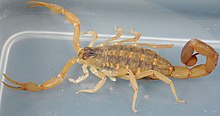Striped bark scorpion
| Striped bark scorpion | |
|---|---|
 |
|
| Scientific classification | |
| Kingdom: | Animalia |
| Phylum: | Arthropoda |
| Subphylum: | Chelicerata |
| Class: | Arachnida |
| Order: | Scorpiones |
| Family: | Buthidae |
| Genus: | Centruroides |
| Species: | C. vittatus |
| Binomial name | |
|
Centruroides vittatus (Say, 1821) |
|
The striped bark scorpion (Centruroides vittatus) is an extremely common scorpion found throughout the midsection of the United States and northern Mexico. It is perhaps the most frequently encountered scorpion in the U.S.
A medium-sized scorpion that is rarely longer than 70 mm (up to around 2 3/4 inches), the striped bark scorpion is a uniform pale-yellow scorpion that can be identified by two dark, longitudinal stripes on its carapace, with a dark triangular above the ocular tubercle. There are minor variations on this theme, however; specimens that are lighter-colored and lack the characteristic stripes have been described as separate species in the past. Their color suits their environment well, providing them with a natural camouflage from predators as well as prey. Males have a pectinal tooth count of 21–30, while females count 20–27.
The natural geographic distribution of C. vittatus is formed by several adjoining South-Central US states and northern Mexico. Beginning in the northern Mexico Border States, Chihuahua, Coahuila, Nuevo León, and Taumalipas, C. vittatus’ range extends upward longitudinally through Texas, Oklahoma, and Kansas, to reach as far north as Thayer Co., Nebraska. The area also extends laterally from the Sangre de Cristo Mountains and Rio Grande in New Mexico and South Colorado to the Missouri and Mississippi Rivers in Missouri and Louisiana. In all, the range includes the following states: Arkansas, Colorado, Kansas, Louisiana, Missouri, Nebraska, New Mexico, Oklahoma, Texas.
Reports have also found C. vittatus in locations inconsistent with the natural geographic distribution aforementioned. Populations seem to be found only in particular cities outside its natural distribution, so it is thought likely that human activity has introduced C. vittatus to these areas. They include locations Iowa (Harrison County), Kentucky (Marshall and Calloway Counties), Louisiana (East Baton Rouge Parish and Orleans Parish), Mississippi (Lamar, Pike and Rankin Counties), Missouri (Clark County), North Carolina (Dare, Nash, and Wake Counties), and Tennessee (Rutherford and Shelby Counties). Additional sightings have occurred in Arizona (Maricopa County), California (Contra Costa County), and Colorado (Boulder County).
A wide geographic distribution allows C. vittatus to occupy desert, deciduous and coniferous forest, and temperate grassland [biomes], where they can be found in crevices under rock and surface debris, vegetation, old rural structures like sheds and barns, and houses during the day. At night, this species emerges from its daytime home and can be found on the open ground or in vegetation like microphyllous desertic brushwood or other classification.
...
Wikipedia
